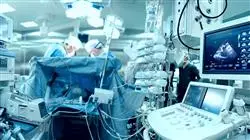University certificate
The world's largest faculty of medicine”
Introduction to the Program
We offer you a quality specialization with which you can expand your competences in the health area. A high-level specialization for professionals seeking to achieve career success”

Clinical ultrasound or point-of-care ultrasound is the technique of ultrasound examination of the body that is used for the practical practice of medicine, related to the direct observation of the patient and his or her treatment. Using this system enhances the ability to diagnose and treat patients. As such, it has become a popular and valuable tool for guiding diagnostic and therapeutic interventions.
Aditionally, technological advances have made it possible to reduce the size of the equipment, making it cheaper and more portable, help increased from the capabilities of clinical ultrasound, achieving a notable increase in its use in various situations.
Clinical ultrasound an impact on each of the six fundamental domains of the current concept of quality of care: patient safety, effectiveness, efficiency, equity, timeliness and humanization. As a result, its use is effective and has become widespread both in primary care and in patients in emergency or critical care situations.
Throughout this specialization, the student will learn all of the current approaches to the different challenges posed by their profession. A high-level step that will become a process of improvement, not only on a professional level, but also on a personal level.
This challenge is one of TECH social commitments: to help highly qualified professionals to specialize and to develop their personal, social and labor competencies during the course of their training.
We will not only take you through the theoretical knowledge we offer, but we will introduce you to another way of studying and learning, one which is simpler, more organic, and efficient. We will work to keep you motivated and to develop your passion for learning, helping you to think and develop critical thinking skills. And we will push you to think and develop critical thinking.
A high-level scientific training program, supported by advanced technological development and the teaching experience of the best professionals”
This Advanced master’s degree in Clinical Ultrasound contains the most comprehensive and up-to-date academic course on the university scene. The most important features of the program include:
- The latest technology in online teaching software
- A highly visual teaching system, supported by graphic and schematic contents that are easy to assimilate and understand
- Practical cases presented by practising experts
- State-of-the-art interactive video systems
- Teaching supported by remote training
- Continuous updating and retraining systems
- Autonomous learning: full compatibility with other occupations
- Practical exercises for self-evaluation and learning verification.
- Support groups and educational synergies: questions to the expert, debate and knowledge forums.
- Communication with the teacher and individual reflection work
- Content that is accessible from any, fixed or portable device with an Internet connection.
- Supplementary documentation databases are permanently available, even after the program
A training program created for professionals who aspire to excellence that will allow you to acquire new skills and strategies in a smooth and effective way”
Our teaching staff is made up of working professionals. In this way, we ensure that we provide you with the training update we are aiming for. A multidisciplinary team of professionals with training and experience in different environments, who will develop the theoretical knowledge in an efficient way, but above all, they will bring their practical knowledge from their own experience to the course.
The efficiency of the methodological design of this Advanced master’s degree, enhances the student's understanding of the subject. Developed by a multidisciplinary team of e-learning experts, it integrates the latest advances in educational technology. In this way, you will be able to study with a range of easy-to-use and versatile multimedia tools that will give you the necessary skills you need for your specialization.
The design of this program is based on Problem-Based Learning, an approach that conceives learning as a highly practical process. To achieve this remotely, we will use remote training learning. With the help of an innovative interactive video system, and learning from an expert, you will be able to acquire the knowledge as if you were actually dealing with the scenario you are learning about. A concept that will allow you to integrate and fix learning in a more realistic and permanent way.
A deep and comprehensive dive into strategies and approaches in application of Clinical Ultrasound”

We have the best teaching methodology and a multitude of simulated cases that will help you train in real situations”
Why study at TECH?
TECH is the world’s largest online university. With an impressive catalog of more than 14,000 university programs available in 11 languages, it is positioned as a leader in employability, with a 99% job placement rate. In addition, it relies on an enormous faculty of more than 6,000 professors of the highest international renown.

Study at the world's largest online university and guarantee your professional success. The future starts at TECH”
The world’s best online university according to FORBES
The prestigious Forbes magazine, specialized in business and finance, has highlighted TECH as “the world's best online university” This is what they have recently stated in an article in their digital edition in which they echo the success story of this institution, “thanks to the academic offer it provides, the selection of its teaching staff, and an innovative learning method aimed at educating the professionals of the future”
A revolutionary study method, a cutting-edge faculty and a practical focus: the key to TECH's success.
The most complete study plans on the university scene
TECH offers the most complete study plans on the university scene, with syllabuses that cover fundamental concepts and, at the same time, the main scientific advances in their specific scientific areas. In addition, these programs are continuously being updated to guarantee students the academic vanguard and the most in-demand professional skills. In this way, the university's qualifications provide its graduates with a significant advantage to propel their careers to success.
TECH offers the most comprehensive and intensive study plans on the current university scene.
A world-class teaching staff
TECH's teaching staff is made up of more than 6,000 professors with the highest international recognition. Professors, researchers and top executives of multinational companies, including Isaiah Covington, performance coach of the Boston Celtics; Magda Romanska, principal investigator at Harvard MetaLAB; Ignacio Wistumba, chairman of the department of translational molecular pathology at MD Anderson Cancer Center; and D.W. Pine, creative director of TIME magazine, among others.
Internationally renowned experts, specialized in different branches of Health, Technology, Communication and Business, form part of the TECH faculty.
A unique learning method
TECH is the first university to use Relearning in all its programs. It is the best online learning methodology, accredited with international teaching quality certifications, provided by prestigious educational agencies. In addition, this disruptive educational model is complemented with the “Case Method”, thereby setting up a unique online teaching strategy. Innovative teaching resources are also implemented, including detailed videos, infographics and interactive summaries.
TECH combines Relearning and the Case Method in all its university programs to guarantee excellent theoretical and practical learning, studying whenever and wherever you want.
The world's largest online university
TECH is the world’s largest online university. We are the largest educational institution, with the best and widest online educational catalog, one hundred percent online and covering the vast majority of areas of knowledge. We offer a large selection of our own degrees and accredited online undergraduate and postgraduate degrees. In total, more than 14,000 university degrees, in eleven different languages, make us the largest educational largest in the world.
TECH has the world's most extensive catalog of academic and official programs, available in more than 11 languages.
Google Premier Partner
The American technology giant has awarded TECH the Google Google Premier Partner badge. This award, which is only available to 3% of the world's companies, highlights the efficient, flexible and tailored experience that this university provides to students. The recognition as a Google Premier Partner not only accredits the maximum rigor, performance and investment in TECH's digital infrastructures, but also places this university as one of the world's leading technology companies.
Google has positioned TECH in the top 3% of the world's most important technology companies by awarding it its Google Premier Partner badge.
The official online university of the NBA
TECH is the official online university of the NBA. Thanks to our agreement with the biggest league in basketball, we offer our students exclusive university programs, as well as a wide variety of educational resources focused on the business of the league and other areas of the sports industry. Each program is made up of a uniquely designed syllabus and features exceptional guest hosts: professionals with a distinguished sports background who will offer their expertise on the most relevant topics.
TECH has been selected by the NBA, the world's top basketball league, as its official online university.
The top-rated university by its students
Students have positioned TECH as the world's top-rated university on the main review websites, with a highest rating of 4.9 out of 5, obtained from more than 1,000 reviews. These results consolidate TECH as the benchmark university institution at an international level, reflecting the excellence and positive impact of its educational model.” reflecting the excellence and positive impact of its educational model.”
TECH is the world’s top-rated university by its students.
Leaders in employability
TECH has managed to become the leading university in employability. 99% of its students obtain jobs in the academic field they have studied, within one year of completing any of the university's programs. A similar number achieve immediate career enhancement. All this thanks to a study methodology that bases its effectiveness on the acquisition of practical skills, which are absolutely necessary for professional development.
99% of TECH graduates find a job within a year of completing their studies.
Advanced Master's Degree in Clinical Ultrasonography
In recent decades, ultrasound has become an essential tool for the work of doctors; since it not only allows to carry out diagnostic tests more accurately and safely, but also because, thanks to its dynamism, portability and effectiveness, it favors the performance of non-invasive and outpatient procedures to a greater number of patients, ensuring their accessibility. Faced with this scenario, at TECH Global University we designed the Advanced Master's Degree in Clinical Ultrasound, a program aimed at updating the ultrasound knowledge and skills of professionals in order to continue offering the best assistance in the approach, management and treatment of the different pathological conditions that arise in their daily clinical practice.
Specialize in the largest Medical School
If you want to stand out as an expert in the use of ultrasound for the approach of conditions, pathological conditions or common diseases in your professional practice, our Professional Master's Degree is the right one. With a curriculum designed with the utmost rigor, you will specialize in the latest advances in this area: its frequent uses, benefits and limitations; you will know how to guide the most advanced diagnostic and therapeutic procedures; and you will practice all ultrasound modalities in the safest way for the patient. In addition, with a solid foundation of knowledge and technical skills, you will be able to participate in the optimization of ultrasound imaging and its use in healthcare, research and academic environments. At TECH we offer you a program of specialization of high scientific level and advanced technological development, what are you waiting for to graduate from the largest Medical School in the world?







